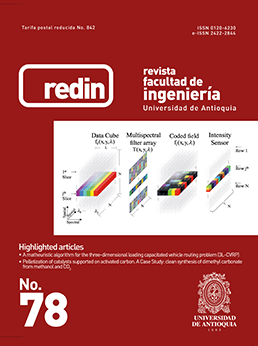Spectroscopic analysis of coal plasma emission produced by laser ablation
DOI:
https://doi.org/10.17533/udea.redin.n78a09Keywords:
Laser Induced Plasma Spectroscopy (LIPS), Optical Emission Spectroscopy (EOS), coal, laser ablationAbstract
An analysis of plasma produced by laser ablation using 1,064 nm of laser radiation from a Q-switched Nd:YAG on coal mineral samples under air ambient, was performed. The emission of molecular band systems such as C2 Swan System , the First Negative System N2 (Band head at 501.53 nm) and different emission lines were investigated using the optical emission spectroscopy technique. The C2 molecular spectra (Swan band) were analyzed to determine vibrational temperature (0.62 eV). The density and electron temperature of the plasma have been evaluated using Stark broadening and the intensity of the nitrogen emission lines (N II). Values of 1.2 eV of electron temperature and 1.82×1019 cm-3 of electron density were found.
Downloads
References
L. Kleiber, H. Fink, R. Niessner and U. Panne, “Strategies for the analysis of coal by laser ablation inductively coupled plasma mass spectroscopy”, Analytical and Bioanalytical Chemistry, vol. 374, no. 1, pp. 109-114, 2002.
S. Harilal, R. Issac, C. Bindhu, V. Nampoori and C. Vallabhan, “Optical emission studies of C2 species in laser-produced plasma from carbon”, Journal of Physics D: Applied Physics, vol. 30, no. 12, pp. 1703- 1709, 1997.
S. Harilal, R. Issac, C. Bindhu, V. Nampoori and C. Vallabhan, “Emission characteristics and dynamics of C2 from laser produced graphite plasma”, J. Appl. Phys., vol. 81, no. 8, pp. 3637-3643, 1997.
C. Romero et al., “Laser-Induced Breakdown Spectroscopy for Coal Characterization and Assessing Slagging Propensity”, Energy Fuels, vol. 24, no. 1, pp. 510-517, 2010.
K. Kohse, R. Barlow, M. Aldén and J. Wolfrum, “Combustion at the focus: laser diagnostics and control”, Proceedings of the Combustion Institute, vol. 30, no. 1, pp. 89-123, 2005.
J. Qiu et al., “Coal gasification in steam and air medium under plasma conditions: a preliminary study”, Fuel Processing Technology, vol. 85, no. 8-10, pp. 969-982, 2004.
H. Riascos, L. Franco and J. Pérez, “Optical spectroscopy of emission from CN plasma formed by laser ablation”, Physica Scripta, vol. 131, 2008.
A. Rojas, J. Barraza and R. Barranco, “Cambios morfológicos de carbones pulverizados durante su desvolatilización”, Revista Facultad de Ingeniería Universidad de Antioquia, no. 52, pp. 75-87, 2010.
L. Franco, J. Pérez and H. Riascos, “Estudio Espectroscópico de Plasmas del Aire Cobre y Aluminio Producidos por Láser Pulsado”, Revista Colombiana de Física, vol. 40, pp. 176-179, 2008.
H. Griem, Plasma Spectroscopy, 1st ed. New York, USA: McGraw-Hill, 1964. 11. H. Griem, Spectral Line Broadening by Plasmas, 2nd ed. New York, USA: Academic Press, 1974.
National Institute of Standards and Technology (NIST), NIST Atomic Spectra Database Lines Form. [Onilne]. Available: http://physics.nist.gov/PhysRefData/ASD/lines_form.html. Accessed on: Apr. 5, 2012.
H. Griem, “Validity of Local Thermal Equilibrium in Plasma Spectroscopy”, Phys. Rev., vol. 131, no. 3, pp. 1170-1176, 1963.
B. Man et al., “Line-broadening analysis of plasma emission produced by laser ablation of metal Cu”, Journal of Optics A: Pure and Applied Optics, vol. 6, no. 1, pp. 17-21, 2003.
G. Bekefi, Principles of laser plasmas, 1st ed. New York, USA: Wiley-Interscience, 1976.
J. Hollas, Modern Spectroscopy, 1st ed. New York, USA: John Wiley & Sons, 1992.
R. Pearse and A. Gaydon, The identification of Molecular Spectra, 1st ed. London, England: Chapman and Hall, 1976.
M. Karim, D. Cameron and M. Hashmi, “Plasma diagnostics in the growth of c-BN films”, Diamond Rel. Mater., vol. 3, no. 4-6, pp. 551-554, 1994.
Downloads
Published
How to Cite
Issue
Section
License
Copyright (c) 2016 Revista Facultad de Ingeniería Universidad de Antioquia

This work is licensed under a Creative Commons Attribution-NonCommercial-ShareAlike 4.0 International License.
Revista Facultad de Ingeniería, Universidad de Antioquia is licensed under the Creative Commons Attribution BY-NC-SA 4.0 license. https://creativecommons.org/licenses/by-nc-sa/4.0/deed.en
You are free to:
Share — copy and redistribute the material in any medium or format
Adapt — remix, transform, and build upon the material
Under the following terms:
Attribution — You must give appropriate credit, provide a link to the license, and indicate if changes were made. You may do so in any reasonable manner, but not in any way that suggests the licensor endorses you or your use.
NonCommercial — You may not use the material for commercial purposes.
ShareAlike — If you remix, transform, or build upon the material, you must distribute your contributions under the same license as the original.
The material published in the journal can be distributed, copied and exhibited by third parties if the respective credits are given to the journal. No commercial benefit can be obtained and derivative works must be under the same license terms as the original work.










 Twitter
Twitter